Bike fitting explained - Adjusting Cleats
|| 20 minutes || 7674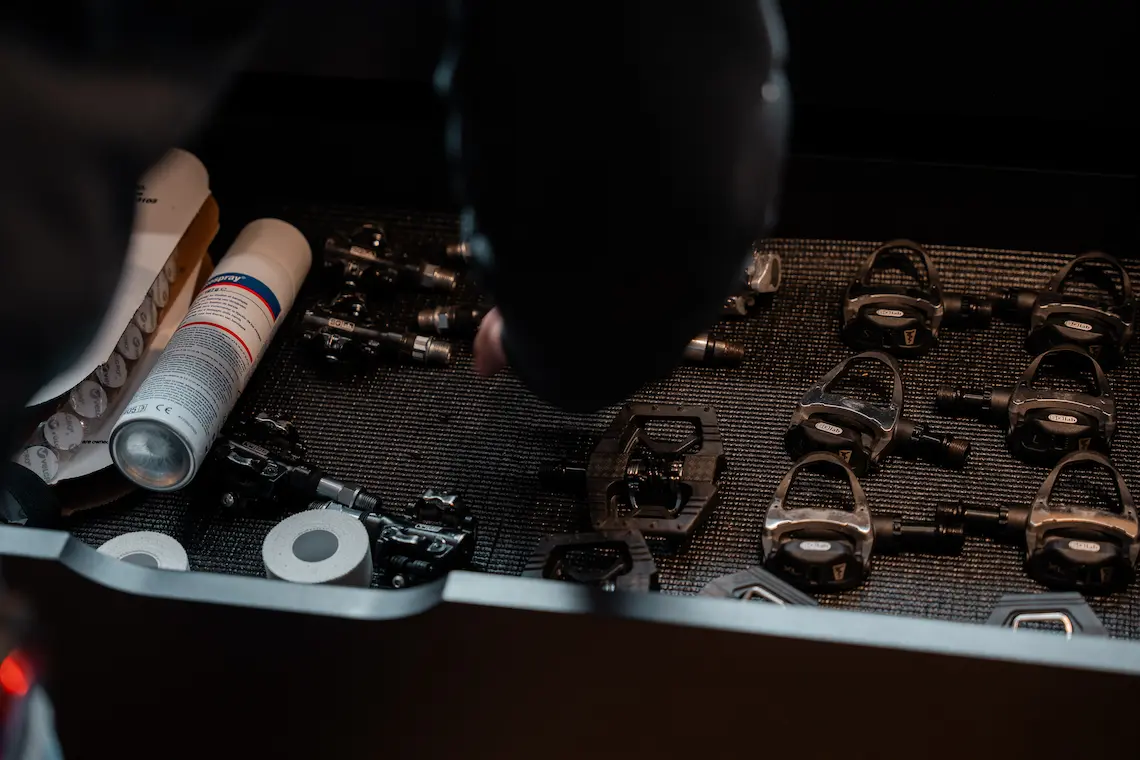
How to Adjust Your Cleats for Injury Prevention, Power Production, and Increased Efficiency
Cycling is a sport that demands a fine balance of endurance, strength, and precision. While most cyclists invest in high-quality bikes, gear, and training plans, one of the most critical aspects of cycling often gets overlooked—cleat adjustment.
Proper cleat positioning on cycling shoes not only optimizes power production and efficiency but also plays a crucial role in preventing injuries. Improper cleat adjustment can lead to knee pain, foot discomfort, and even chronic overuse injuries.
But before we get started lets understand what exactly the cleat is responsible for in the overall cycling experience.
Understanding the Cycling Cleat and why are they important
Cycling cleats play a crucial role in connecting a cyclist’s shoes to the pedals, which provides several specific benefits. They attach to the sole of a cyclist's shoe and clip into a corresponding pedal system. Cleats are responsible for:
1. Efficient Power Transfer:
- Responsibility:
The cleats help transfer power from the cyclist’s legs directly into the pedals in the same position repetitively because they keep the foot locked in place. - Importance:
With flat pedals, only the downward phase of the pedal stroke (the push) is efficient, and the foot can move freely. In contrast, cleats allow the rider to apply force during both the downstroke and additional, less efficient vector forces—forward, backward, and upward. While these forces aren't as effective, they still contribute to stronger pedaling overall.
2. Pedaling Consistency and Stability:
- Responsibility:
By keeping the foot fixed in an optimal position on the pedal, cycling cleats help maintain consistent foot placement throughout the ride. - Importance:
Maintaining a consistent foot position minimizes unnecessary lateral movement, reducing wasted energy and enhancing pedaling biomechanics. It also ensures the foot is properly aligned, preventing misalignment that can negatively impact the rider's overall sitting posture on the bike.
3. Reduction of Fatigue and Injuries:
- Responsibility:
Properly fitted cleats align the foot, knee, and hip joints, promoting proper biomechanics. - Importance:
Proper alignment minimizes strain on the joints and muscles, especially during repetitive motion. Cleats, by allowing the foot to rotate slightly during pedaling (float), help reduce the risk of knee injuries caused by misalignment or excessive joint pressure.
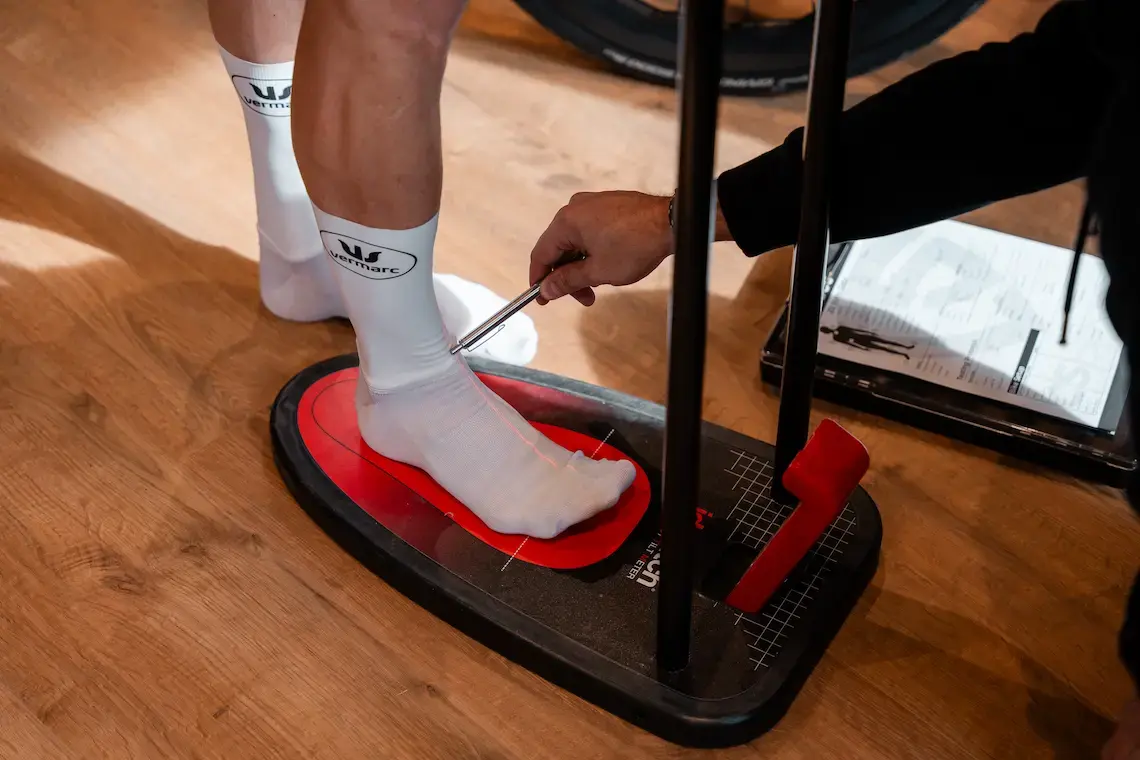
Understanding the Cleat, the terms used and its features
Before delving into the specifics of cleat adjustment, it’s essential to understand the three primary aspects of cleat positioning:
- Fore-Aft (Forward-Backward) Adjustment:
This refers to the positioning of the cleat along the length of the shoe sole. Adjusting the cleat forward or backward determines how your foot is positioned relative to the pedal axle. - Lateral Adjustment:
This is the side-to-side placement of the cleat on the shoe, which affects how your foot is aligned over the pedal. Proper lateral alignment ensures your knees track correctly during the pedal stroke. - Angular (Rotational) Adjustment:
This determines the angle at which your foot points while clipped into the pedal (toe-in, toe-out, or neutral). Incorrect angular alignment can cause knee, hip, or ankle discomfort as it forces your leg into an unnatural tracking position during pedaling. - Pedal Tension Adjustment:
Pedal Tension refers to the adjustable resistance or force required to clip into and release your cycling shoes from the pedals. Pedal Tension does not directly affect float, it can affect how easily your foot pivots when clipped in. Lower tension may give you the feeling of more float, as your foot can rotate more freely, while higher tension can make the pedal feel more restrictive, potentially reducing your effective float. - Float Adjustment:
Float refers to the amount of angular movement your cleat allows while clipped into the pedal. It provides a small range of motion, allowing your foot to pivot slightly during the pedal stroke. Float reduces the likelihood of stress on the knees, but too much or too little float can impact pedaling efficiency and stability.
Float Adjustment: Cleat Type and Model by Brand and how to adjust
Pedal float is largely determined by the cleat and pedal system you are using. Most cleats and pedals come with pre-set float ranges, and the type of cleat you use will dictate how much float you have.
| Cleat System / Interface | Float System |
|---|---|
| Look (Keo) Cleats System | Black cleats: 0° float (fixed, no movement) Grey cleats: 4.5° float (moderate movement) Red cleats: 9° float (maximum movement) |
| Shimano SPD-SL Cleats | Red cleats: 0° float (fixed) Blue cleats: 2° float (slight movement) Yellow cleats: 6° float (most float) |
| Speedplay Pedals | With Speedplay, you can customize the exact amount of float (from 0° to 15°) using screws on the cleats. You can set the upper and lower limits for the range of movement, providing the most customizable float adjustment of any pedal system |
| Shimano SPD (Mountain Bike) Cleats | Most Shimano SPD pedals for mountain biking provide about 6° of float, though it’s typically fixed by the pedal design. You would need to change the cleat type or switch to a different pedal system if you need more or less float. |
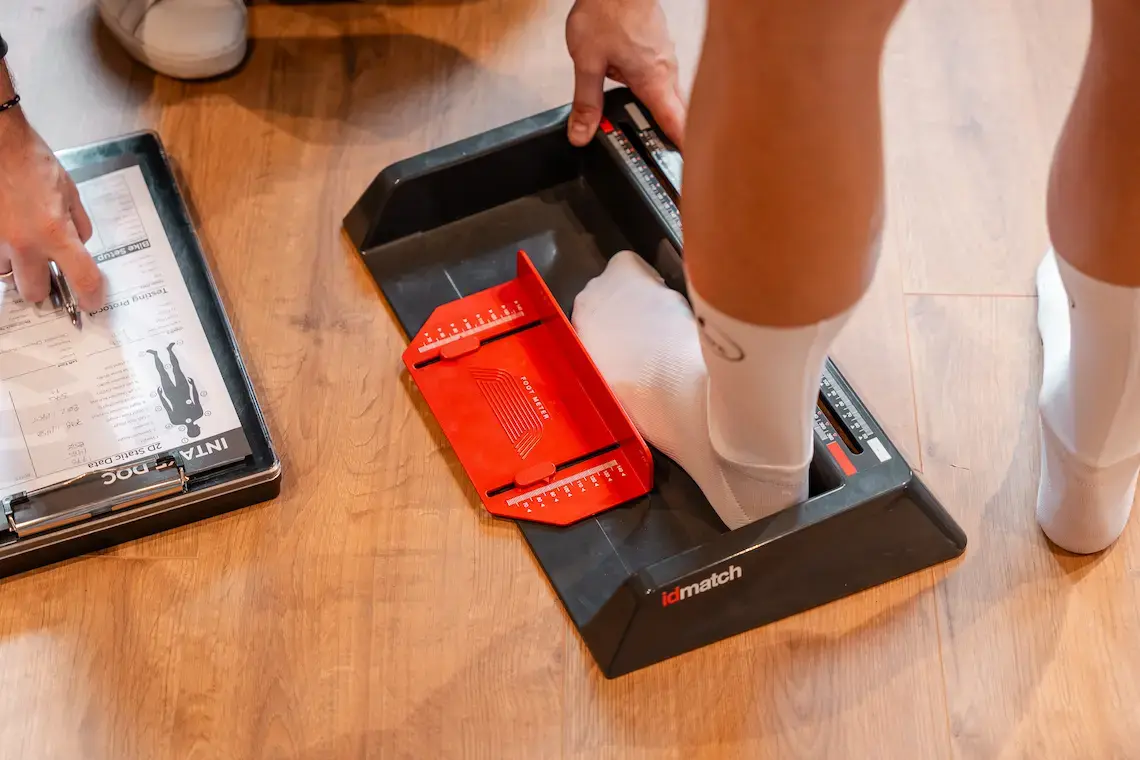
Concepts for cleat position
Lets investigate the key components we would like to achieve with a properly fitted cleat and how it aids in power production and efficiency.
Cleat Adjustment for Power Production
For cyclists aiming to maximize their power output, cleat adjustment is essential. The way the cleat is positioned on your shoe directly impacts your ability to deliver force efficiently to the pedals.
| Fore-Aft Positioning for Maximum Power | Optimal Position |
|---|---|
| The forward-backward position of the cleat affects how effectively your muscles generate power. A cleat positioned too far forward will overly engage the calves, while a cleat placed too far back can reduce the leverage of the quads and hamstrings. | Optimal Position: For power production, the cleat should be positioned so that the foot's metatarsal bones are directly on above or slightly behind the pedal axle. This will engage the larger, more powerful muscles like the quads and glutes. Moving the cleat slightly further back will activate the posterior chain (glutes and hamstrings) more effectively, allowing for greater power over long distances. |
| Lateral and Angular Alignment for Power Transfer | Optimal Alignment |
|---|---|
| If your cleats are positioned laterally in a way that doesn’t match your natural foot alignment, you may experience power loss due to inefficient pedaling mechanics. Misalignment causes the pedal stroke to lose its circular motion, leading to uneven force distribution. | A neutral lateral position ensures that your foot is properly aligned over the pedal, optimizing force transfer during the downstroke. Cyclists who naturally pedal with their toes pointing inward or outward should adjust their cleats accordingly to maintain biomechanical efficiency. Float should be set in a balanced, centered position—not too restricted in either direction—allowing for unexpected situations where your foot may need to rotate further than usual without unintentionally disengaging from the pedal. |
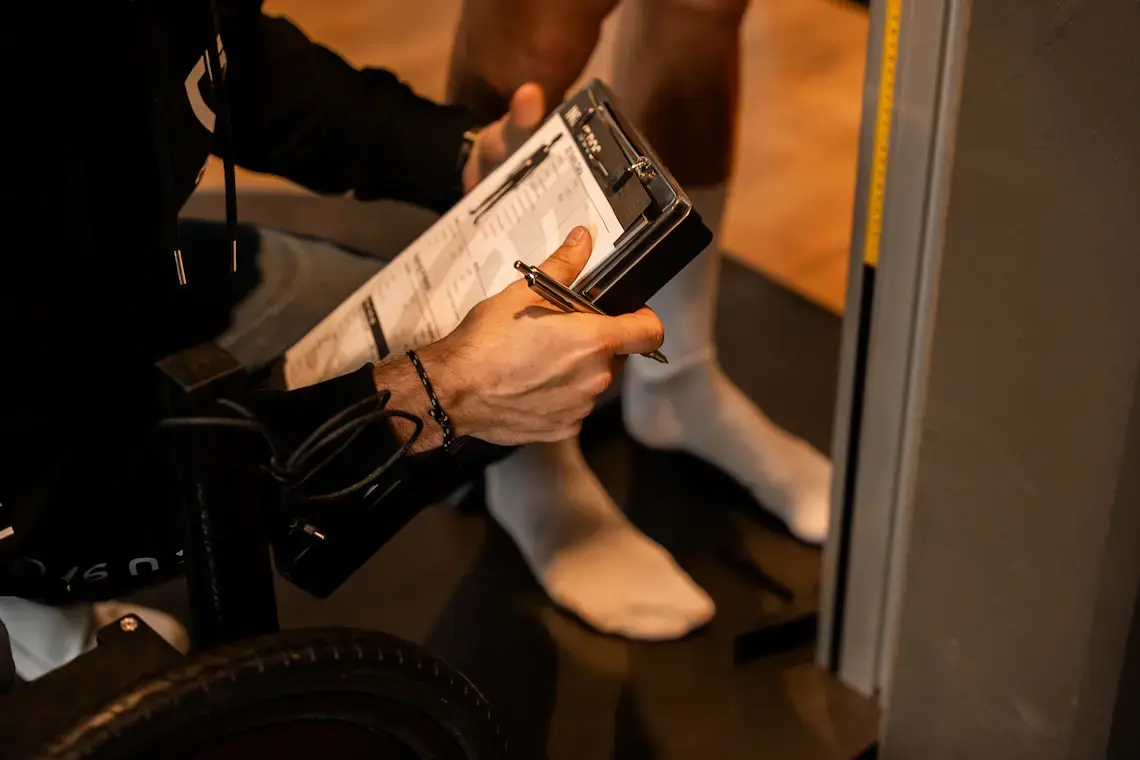
Cleat Adjustment for Increased Efficiency
Efficiency in cycling refers to how much energy you expend to maintain a certain speed or power output. An efficient cyclist wastes less energy on extraneous movements or improper muscle engagement. Proper cleat positioning is crucial in maintaining this efficiency over long rides.
| Fore-Aft Position for Endurance | Optimal Position |
|---|---|
| A cleat positioned too far forward can overburden the calf muscles, which are primarily responsible for plantar flexion, ankle and foot stability, and shock absorption. The calf muscle group consists of the gastrocnemius, which is suited for explosive movements, and the soleus, which is designed for endurance and sustained activity. While the calf muscles contribute to power transfer, their main function is to fine-tune the distribution of force rather than generate power. Overloading the calves can lead to excessive fatigue and muscle failure. On the other hand, a cleat positioned too far back may reduce power efficiency from the quads. However, positioning the cleat slightly back is generally a safer choice, as it helps minimize unnecessary muscle fatigue and conserve energy. | Positioning the foot so that the metatarsal bones are directly above or slightly behind the pedal axle engages the larger, more powerful muscles, such as the quads and glutes. This alignment creates a balance between power production and endurance, allowing for consistent power output without prematurely fatiguing specific muscle groups. |
Float, Tension and Efficiency
While float is crucial for injury prevention, having too much float can reduce pedaling efficiency by allowing excessive foot movement, which can lead to energy wastage. Finding the right balance of float helps optimize pedal stroke consistency.
| Cleat Tension | Optimal Float |
|---|---|
| Overly tight cleats can restrict the natural movement of the foot, reducing the amount of float available and causing the foot to remain in an unnatural position during the pedal stroke. This can lead to muscle strain, inefficient power transfer, and discomfort in the knees and ankles. Conversely, if the cleat tension is too low, the foot may disengage from the pedal unintentionally, disrupting the pedal stroke and decreasing control. | Efficient cycling requires just enough float to allow for natural foot movement, but not so much that your feet are constantly rotating unnecessarily. Most riders find that 4-6° of float is ideal for efficient riding, particularly for long-distance cycling. However this is better determined within a cleat fitting which will take all of your biomechanical features into account. |
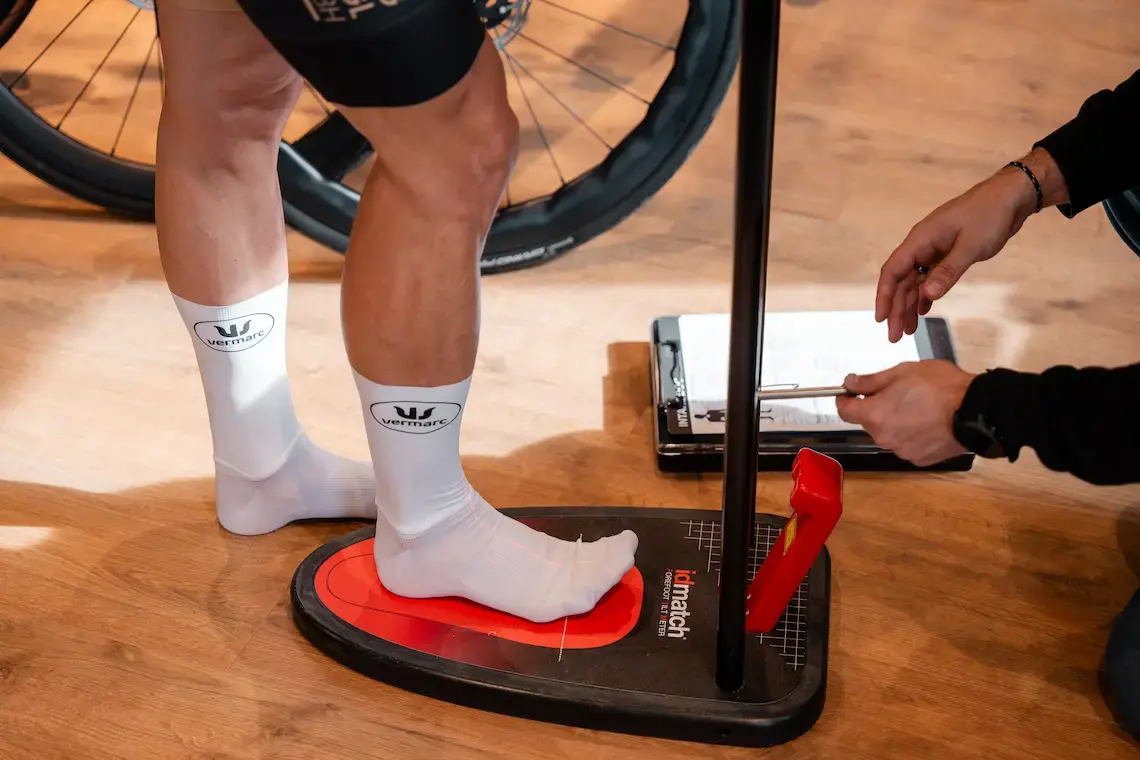
Lets talk about discomfort and how to correct it
We often receive questions about cleat-related issues, typically revolving around some form of discomfort. Over time, I've come to realize that this is a commonly misunderstood topic, despite its potential to greatly impact your cycling experience. The cleat interface plays a crucial role in power transfer, serving as one of the three main connection points between the rider and the bike. I believe it deserves more attention and should always be properly addressed to enhance comfort and performance.
Let's break down some common issues and how we can potentially correct them to find a more powerful, efficient and comfortable riding experience.
| Location of Discomfort | Suggested Change | Explanation |
|---|---|---|
| Anterior Knee Pain (Patellofemoral Pain) “Pain in the front of the knee” Important note: There may be underlying issues with your saddle position, cycling shoes, or overall bike geometry. If you're uncertain whether the knee discomfort is related to your cleat setup, it's advisable to consult a professional bike fitter for a thorough assessment. |
Fore-Aft Positioning | When the cleat is too far forward, it shifts the pedal stroke, causing excessive force on the knee joint, especially during the downstroke. Move the cleat slightly backward along the shoe to position the foot more directly over the pedal axle. |
| Angular or Float Adjustment | Lack of float can cause excessive tracking of the knee and increase strain on the knee joint. Increase the amount of float in the cleat (especially for road cycling) to allow your foot to rotate slightly during the pedal stroke. |
|
| Lateral Adjustment | If your foot is angled inwards or outwards too much, it can misalign the knee, contributing to pain. Check the lateral position of the cleat to ensure that it is aligned with the natural angle of your foot. |
|
| Posterior Knee Pain (Popliteal Fossa Pain) “Pain in the rear of the knee” Important note: There may be underlying issues with your saddle position, cycling shoes, or overall bike geometry. If you're uncertain whether the knee discomfort is related to your cleat setup, it's advisable to consult a professional bike fitter for a thorough assessment. |
Fore-Aft Positioning | If your cleats are positioned too far forward on your shoes, it can cause the knee to overextend during the pedal stroke, leading to excessive stress on the hamstrings. Shift the cleat slightly backward, allowing the pedal to engage your quads and glutes more effectively, and reducing the load on the hamstrings and knee joint. |
| Angular or Float Adjustment | Incorrect angular alignment (e.g., too much inward or outward rotation) can cause the knee to track improperly, contributing to discomfort at the back of the knee. If the cleats have too much or too little float, this can restrict natural foot movement, forcing your knee into an awkward position. If you naturally pedal with a slight toe-in or toe-out, adjust the cleats accordingly to maintain proper tracking and prevent knee strain. |
|
| Medial Knee Pain “Pain on the inside of knee” Important note: Lateral knee discomfort can be challenging to resolve. If you're unsure whether the discomfort is linked to your cleat setup, it's recommended to seek guidance from a professional bike fitter for a comprehensive evaluation. |
Lateral Adjustment | If your cleats are positioned too far inward, it can cause the knee to track incorrectly and put excessive stress on the inner part of the knee Move the cleat outward (laterally). This will help align the foot with a more neutral position |
| Float or Tension Adjustment | If your cleats have float (angular movement), too little float can restrict natural foot movement, forcing the knee to compensate. Increase the float slightly and/or Reduce Pedal Tension, allowing more rotational movement of the foot. |
|
| Fore-Aft Positioning | While fore-aft adjustments are typically more related to comfort and pedaling efficiency, it can also impact knee alignment. Try adjusting the cleats slightly backward, which can sometimes help with knee pain by improving the biomechanics of the pedal stroke |
|
| Lateral Knee Pain “Pain on the outside of knee” Important note: Lateral knee discomfort can be challenging to resolve. If you're unsure whether the discomfort is linked to your cleat setup, it's recommended to seek guidance from a professional bike fitter for a comprehensive evaluation. |
Lateral Adjustment | Pain on the outside of the knee can be caused by the foot being positioned too far outward in relation to the pedal. Move the cleat slightly inward (toward the bike). This adjustment helps align the foot and knee in a more neutral position. |
| Angular Adjustment | If your cleat is positioned too far out or angled in a way that forces your foot to point outward. Adjust the cleat so the foot is in a more natural, straight position on the shoe. |
|
| Float or Tension Adjustment | If your cleats allow for too much lateral movement (float) If you have too much float, decrease it slightly to provide a more stable foot position If you have too little float, increase the range to allow your foot to move more naturally |
|
| Foot Numbness and Hot Spots | Fore-Aft Position Adjustment | Usually due to cleats being positioned too far forward. This causes excessive pressure on the nerves and blood vessels in the forefoot, leading to reduced circulation and numbness. Move the cleat slightly backward, this redistributes the pressure more evenly across the foot and reduces localized stress |
| Cleat Tension Adjustment | Cleat tension is too tight, restricting natural foot movement. If your cleats are too tight, consider loosening the pedal-release tension |
|
| Ankle Pain | Angular Adjustment | Improper cleat alignment can lead to ankle pain, often caused by excessive inward or outward rotation of the foot while pedaling. This misalignment forces the ankle joint to compensate for the improper positioning, leading to strain. Ensure the cleat is aligned so that your foot’s natural angle is maintained. If your foot naturally points inward or outward, adjust the cleat to accommodate this positioning. |
| Hip Pain | Float Adjustment | Hip pain can result from a cleat that is misaligned laterally or if the cleat’s float is restricted too much. When the hips cannot follow their natural alignment during pedaling, the muscles around the hips, particularly the gluteal muscles, can become overstrained, causing pain and discomfort. Ensure your cleats allow your hips to track naturally in line with your knees and feet. Adjust the cleat angle to match the natural angle of your foot. Introducing a bit more float (4-6°) will allow for minor adjustments in foot positioning throughout the pedal stroke |
| Lower Back Pain Important Note: While adjusting cleats, it is important to ensure your saddle is at the correct height and position. Adjustments at the cleats will result in adjustments that must be made at the saddle. A professional bike fitting may be needed to optimize the entire system, including saddle and cleat positions. |
Fore-Aft Position Adjustment | Lower back pain is commonly caused by poor posture on the bike, but incorrect cleat positioning can also contribute. Adjust the cleat position so that the ball of your foot is directly over or slightly behind the pedal axle. |
| IT Band Syndrome (Lateral Knee and Hip Pain) Problem: Iliotibial (IT) band syndrome is a common overuse injury among cyclists and is often caused by improper lateral cleat alignment. When the IT band becomes overly tight due to poor alignment, it can lead to pain on the outside of the knee or hip. Fix: + Lateral Cleat Position Adjustment: Ensure that your cleats are positioned so that your knee tracks directly over your foot during the pedal stroke. Adjust the cleat’s lateral position slightly inward or outward to match your natural foot alignment, preventing excessive strain on the IT band. + Float Adjustment: If you suffer from IT band syndrome, consider increasing the cleat’s float to allow for more natural foot movement. This reduces the likelihood of your knees and hips being forced into an unnatural tracking pattern. |
||
To how do you know you need a professional cleat fit
Cleat positioning is a small but critical component of cycling that can significantly affect comfort, performance, and injury prevention. Many common discomforts, such as knee pain, foot numbness, and hip or ankle pain, can be traced back to incorrect cleat alignment. By making small adjustments to the fore-aft position, lateral alignment, and float, you can alleviate these issues and improve your overall cycling experience.
Cyclists experiencing persistent discomfort should consider visiting a professional bike fitter who can offer personalized cleat and bike setup recommendations. By fine-tuning your cleat position, you’ll not only prevent injuries but also enhance your efficiency, allowing you to ride further and faster with less strain on your body.
Nicholas Schick, an American residing in Germany, is the founder of CSBikes and has served as Geschäftsführer since 2020. With 15 years of fitting experience, he pioneered the fitting concepts that now guide all operations at CSBikes. His approach includes a comprehensive preparatory fitting process, utilizing Dynamic 3D motion systems, pedaling analysis, and pressure mapping and is certified by Shimano-Labs BikeFitting, SQ-Labs, and ID-Match.

